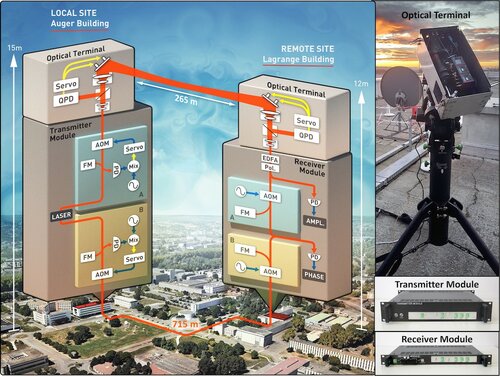This world record was made possible by combining the Australians’ "phase stabilization" technology with advanced self-guided optical terminals. Together, these technologies enabled laser signals to be sent from one point to another by correcting fluctuations introduced by atmospheric turbulence. This is the world’s most accurate method for comparing clocks between two distinct locations.
The team, which includes researchers from SYRTE, the Centre National d’Etude Spatiale (CNES), and the University of Western Australia (ICRAR-UWA), published a study this Friday, January 22, 2021 in the journal Nature Communications.
Lead author Benjamin Dix-Matthews, a doctoral student at ICRAR and UWA, said the technique effectively eliminates atmospheric turbulence. "We can correct atmospheric turbulence in 3-D, which is left-right, up-down and critically along the flight line... It’s as if the moving atmosphere has been removed and doesn’t exist. This allows us to send very stable laser signals through the atmosphere while maintaining the quality of the original signal".
The French-Australian demonstration experiment between two buildings on the CNES premises in Toulouse is a first step towards the implementation of longer distance laser links using airborne relays, or links between the ground and satellites in space, as illustrated in the diagram below :

The comparison of time scales between optical atomic clocks on ground-space laser links and free space ground laser links will have enormous benefits for basic and applied science.
- In fundamental physics, this method tests Einstein’s prediction that clocks located at different locations beat at different rates.
- In more applied sciences, such as geodesy and geophysics, the comparison of clocks located at different locations will allow new measurements of local gravitational potentials. This emerging technique is known as "chronometric geodesy" and takes advantage of the best atomic clocks and frequency comparison systems currently available using laser transmissions.
There are also applications for optical communications, where the transmission of light in free space to carry information is an emerging field with potential advantages. Indeed, optical communications can securely transmit data at much higher data rates than current radio communications.
Bibliography
- "Point-to-Point Stabilised Optical Frequency Transfer with Active Optics"
Benjamin P. Dix-Matthews, Sascha W. Schediwy, David R. Gozzard, Etienne Savalle, François-Xavier Esnault, Thomas Lévèque, Charles Gravestock, Darlene D’Mello, Skevos Karpathakis, Michael Tobar, Peter Wolf
